Bathroom wall lamps
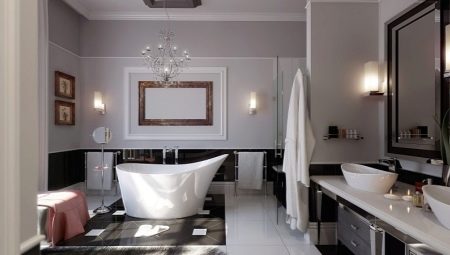
Bathroom lighting is essential. Let's consider in more detail the wall lamps for the bathroom, their features and requirements, types and selection criteria.
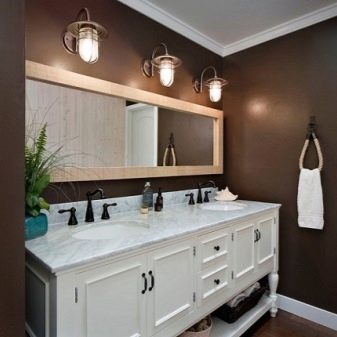
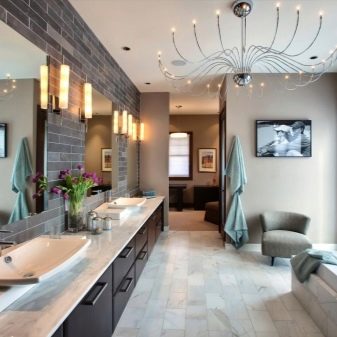
Features and requirements
The main difference between waterproof luminaires and the rest is their design and technical characteristics. The device is equipped with a number of additional elements to prevent moisture from entering key structural elements such as the socket and terminals. The moisture resistance of ordinary lamps is not typical, therefore, before purchasing, it is recommended to pay attention to the documentation of the device. There are two basic requirements for bathroom wall lamps.
- Security. In high humidity it is very important that the wiring is well protected. Therefore, wall sconces in the bathroom usually have a closed waterproof case.
- Intensity (brightness)... Here it is not so much about reliability as about comfort. The light level is selected individually for each client. Depending on the type of lamps, the power indicator changes (measured in watts). For example, LEDs are 6 to 9, and halogen lamps are 23 to 28. For darker bathrooms, it is recommended to use more powerful light sources.
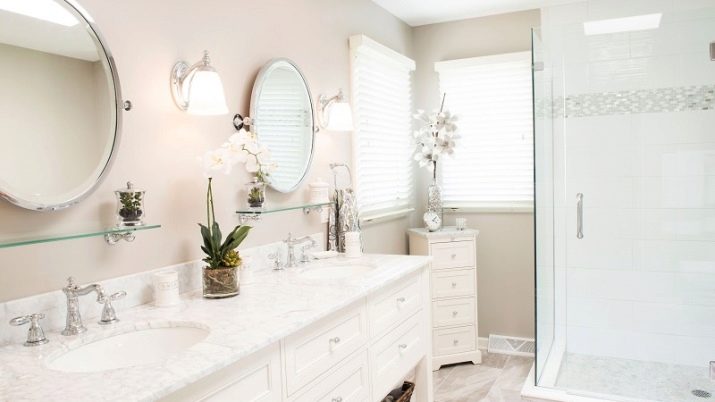
Species overview
All waterproof luminaires can be divided into several types depending on the design features and the degree of protection. In specialized stores, the following types of lamps are provided to the attention of customers:
- built-in;
- overhead (wall);
- hanging (chandeliers);
- floor.
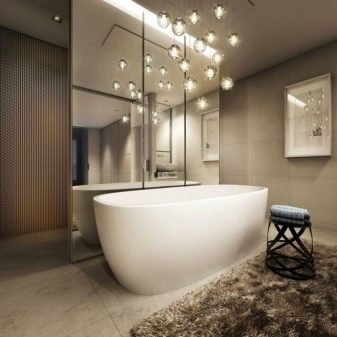
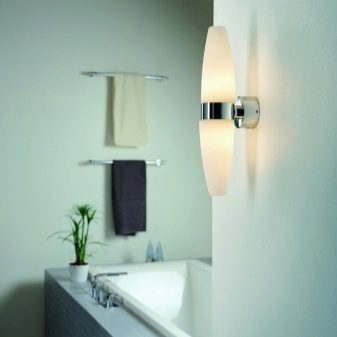
By design
Recessed and pendant lights are quite common and come in a variety of shapes and styles. Of the pendant, chandeliers and lamps are the classic options. Recessed luminaires are also lamps of varying power and technical properties. Depending on the complexity of the structure, the complexity of installation also changes.
- Floor lamps are suitable for spacious rooms. Usually these are tall floor lamps, but sometimes the ceiling is mounted directly into the floor. Sometimes they can serve as a hanger, illuminated. In this case, several shades are usually presented.

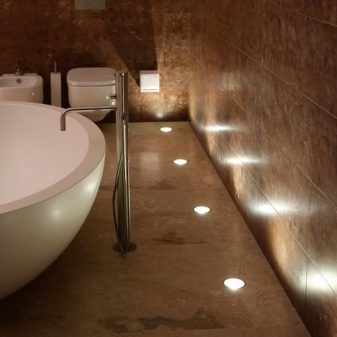
- Mounting wall lighting is suitable for rooms of any size. They are often installed on either side of the mirror and equipped with a switch to adjust the light intensity. LED strips are installed along walls or at the base of the ceiling. Installation is carried out at the end of the repair work; a special switch is mounted to regulate the lighting.

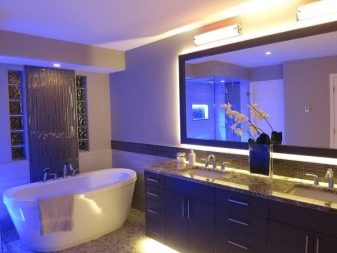
- Luminaires mounted in the bottom or door of the cabinet, are also used quite often today.

Depending on the type of construction, lamps are also installed of a certain type. Best suited are halogen ones, which themselves have built-in moisture protection. Fluorescent and incandescent lamps can also be used, but during installation it is imperative to take care of the protective case, which must be sufficiently sealed. The color shade can be different: from warm yellow to cool blue.
Important! When choosing products, it is better to take all the components from one manufacturer, which will avoid inconsistencies with both the design and the technical part.
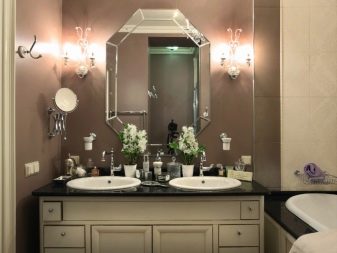
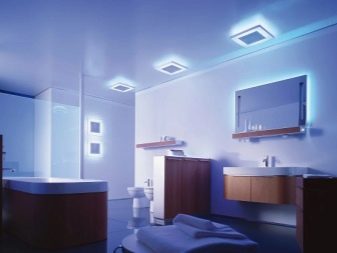
By degree of protection
Outwardly, they have no visual differences from their simpler counterparts. In the documents, the moisture protection of the device is marked with an IP line with the numbers. Protection is indicated on the packaging, for rooms with high humidity levels it must comply with domestic and international manufacturing standards.
The enclosure protection rating is assigned to all electrical appliances. The design provides a number of additional elements to protect functionally important parts. This determines the optimum operating conditions.
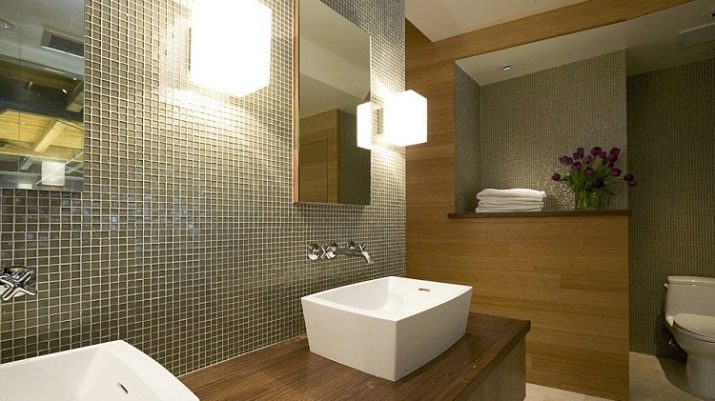
IP numbers have a strictly defined designation, namely:
- protection against the ingress of small particles of dust and dirt;
- the level of protection of the body of the light fixture from water - the higher this indicator, the better the device is protected.
For example, if the IP 54 indicator is indicated in the documents, this means that the device will calmly endure exposure to dust and solid particles without affecting its performance. Splashes of water can also enter the device, but the targeted use of jets of water is not recommended. The set of shower stalls already has lighting, so no additional installation of a lamp is required. For installation under water, LED devices with an indicator of at least 68 are more suitable.

Materials (edit)
If we talk about materials for manufacturing, then the list is very wide, ranging from wood to modern plastic, decorative glass or chrome steel. Wall sconces can be made of various materials with functions of moisture and dust resistance. In addition, the properties of the base material are taken into account, which is used when creating a specific model. For example, if a tree acts as a basis, then its following advantages should be noted:
- environmental friendliness - the composition contains resins that release useful microelements, having a beneficial effect on the respiratory tract;
- ease of processing at the production stage - unlike steel or plastic, it does not require large expenditures for specialized equipment;
- strength and durability - the surface must be treated with special compounds or varnishes to reduce the risk of mold or mildew.
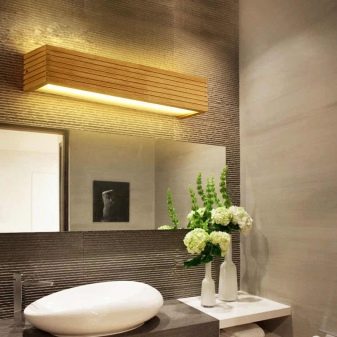
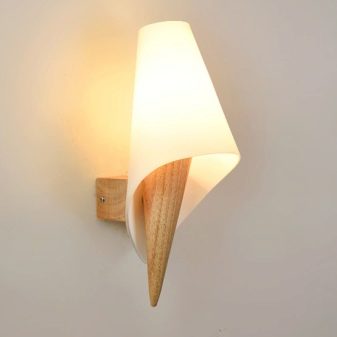
You can pick up a lamp made of plastic, steel or even glass. The main advantages of all of the above are durability and unpretentiousness in care, but it is worth considering that among themselves the models can differ in price and characteristics.
Regardless of the selected material, the main thing is that the structure is equipped with all the necessary structural elements.

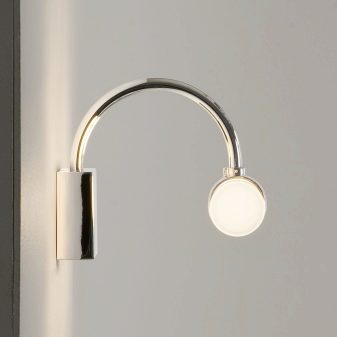
Style solutions
If we talk about style, then everything here depends not only on the selected materials, but also on the design and lighting features. In this case, the buyer is given several options to choose from.
- Simulated window - This is a pretty nice kind of decoration in an urban setting. For this, a suitable section of the wall is selected, its dimensions are measured, after which a lightbox with the desired landscape is purchased as a replacement for an ordinary window. The lightbox itself is a device with a flat surface, the light of which is distributed over the entire plane, projecting the selected image. It can be anything from a starry sky to a winter landscape.
If we talk about the main area of use, then advertising is often placed on the streets with the help of a lightbox. The design includes LED strips, located inside in a strictly defined order and providing a high-quality picture.
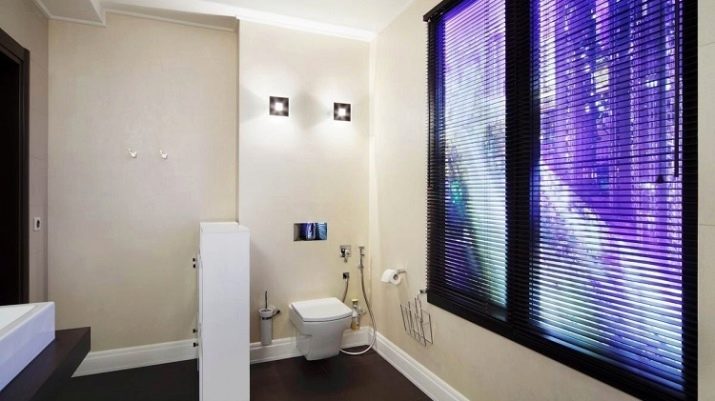
- "Zone" lighting is suitable for rooms with partitions. A color scheme or a certain tone is selected for each area. Hanging sconces or table lamps are more suitable for the sink, and the bathroom area should be illuminated by a separately selected device. Such a solution is not suitable for small-sized premises, since visually the dimensions will seem even smaller than they actually are.
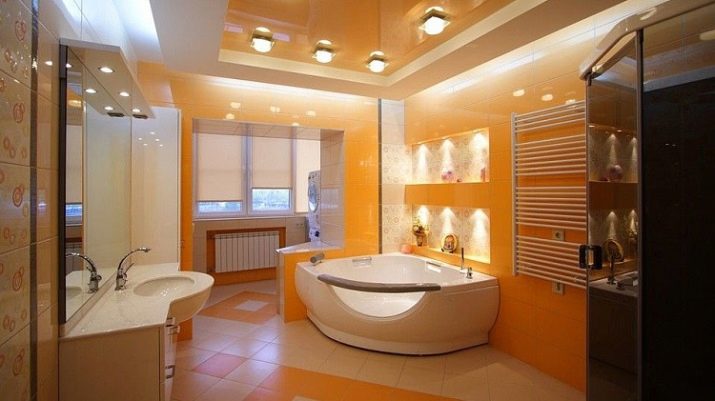
- LED lighting is used most often as an additional source of illumination, or to highlight certain details in a room. For this, both tapes and fluorescent lamps of various powers are used. The illumination area is selected by the client independently. It can be either monolithic or point or linear. The client always has the opportunity to discuss key details with an expert and choose the most suitable option.
Important! When using stretch ceilings, the technology for installing lamps also changes. It is strongly recommended that you consult with a professional before purchasing.
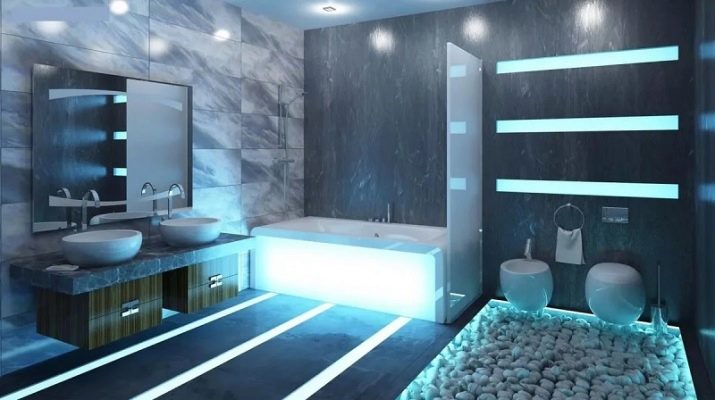
Criterias of choice
One of the main selection criteria is the correct distribution of light in the room. The presence of a sconce near the mirror with the ability to adjust will increase the amount of light at a certain moment. If the room is divided by partitions, then certain areas will need to be illuminated. The ability to adjust the intensity will easily solve the problem of insufficient lighting. It is recommended to pay special attention to the area near the washbasin or mirror, as well as the bath or shower stall, if there is no default light there.
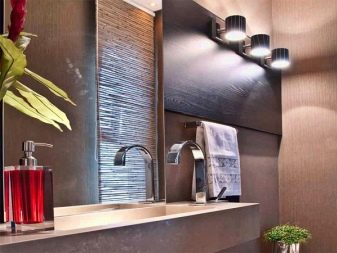
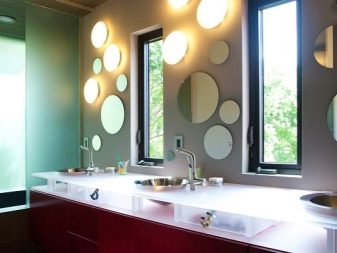
Beautiful examples in the interior
A waterproof luminaire in a bathroom is not only a necessity from a functional point of view, but also an important detail in the organization of the interior. To achieve a relaxing atmosphere, several types of lighting can be combined, provided that the brightness is adjusted, the user always has the opportunity to create a special atmosphere in the room.
For example, bright lighting is suitable for a hall or living room, which will allow, if necessary, to take high-quality photographs with guests. For the bathroom, on the contrary, soft, dim light is more suitable.
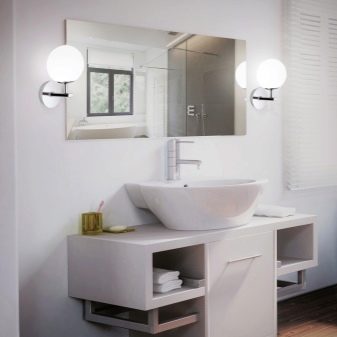
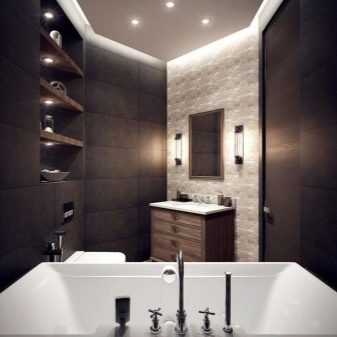
Lamps of a certain style are selected for the general interior of the room. As an example, experienced designers mention several solutions.
- Classic style... Most often, lamps are used with various curly shapes.
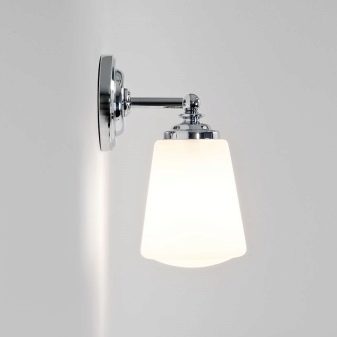
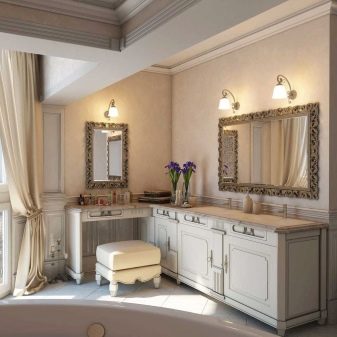
- Modern or contemporary... Severe geometric shapes and clear color combinations are welcome here.Sometimes the design uses a soft, glossy surface.
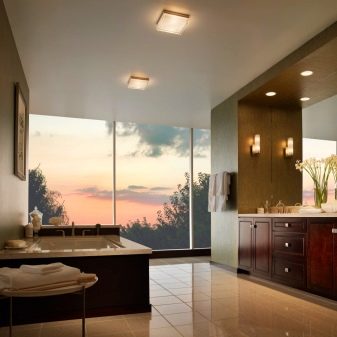

- Combined style. The combination of modern and classic is also very popular. Severity of colors and unusual shapes of lamps coexist here. When choosing this style, you can highlight window and door openings.


- High tech - style with perfectly geometric shapes and subdued lighting of devices.
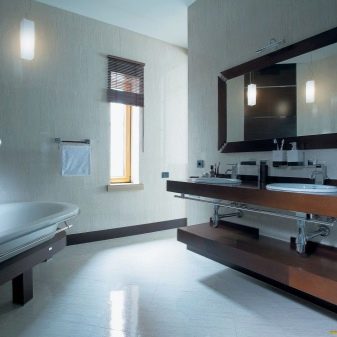
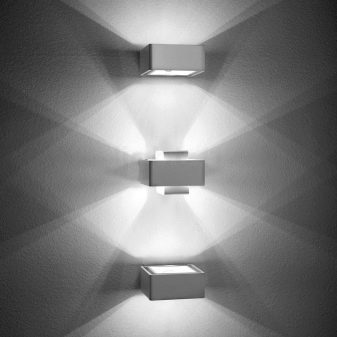
Any of the above decorative solutions can be suitable for the bathroom. The process takes into account the overall design of an apartment or house and the size of the room as a whole.
If you have any difficulties, you can always seek help from a specialist.
For information on how to make the right lighting in the bathroom, see the next video.








